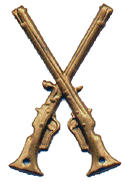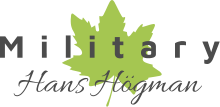

Copyright © Hans Högman 2019-05-20
Swedish Regiments of
the Allotment System -
Infantry (1)
Infantry Regiments:
1. Swedish Regiments -
Infantry (1)

Infantry
Infantry was the name of the army units that fought
by foot as well as was transported by foot. Therefore,
in the beginning they were called foot soldiers. The
term infantry wasn’t in use until the beginning of the
17th century.
The smallest tactical unit used by the infantry in
battle was the battalion. A regiment of 1200 soldiers
had 8 companies of 150 men. They were formed into
two battalions of 600 men each.
Each company had 6 "korpralskap" (corporalship?) of
24 soldiers and one corporal, in total 25 men.
During the Great Nordic War (1700 - 1721) a 1/3 of
the soldiers in each company were armed with pikes
while 2/3 were armed with muskets.
The first company in each regiment was called the
Life Company and was under command of the
colonel. The colonel was also the commander of the
first battalion while the lieutenant colonel was the
commander of the second battalion.
The infantry unit codes begin with letter “I”
followed by a number; for example, I8 (8th Infantry
Regiment).
The provincial regiments of the Allotment
System
Swedish name: Upplands regemente, I8
The regiment was first established in
1626 as the Uppland Regiment. The
regiment was linked to the Allotment
System in December 5, 1682.
In 1904 the regiment received the
name The Uppland Infantry
Regiment. In 1928 the regiment once
again received the name The Uppland Regiment.
The regiment was disestablished in 1957. The
Uppland Signal Regiment moved into the barracks of
the Uppland Regiment the very same year.
The regiment's history goes back to the "fänikor" that
was raised in the province of Uppland in the 16th
century. In the 1620's, King Gustav II Adolf formed a
"landsregemente" - a Grand Regiment, from the
Uppland fänikor and from fänikor in the provinces of
Dalarna and Västmanland.
In 1626 the Grand Regiment was split up into three
independent regiments, The Uppland Regiment, The
Västmanland Regiment and the Dal Regiment (The
Dalecarlia Regiment).
As a result of the Constitution adopted in 1634 the
Army was reorganized. The Uppland regiment was
then referred to as the "1st Regiment".
The regiment was allotted with 1200 "rotar".
Hence, the Regiment had 1200 soldiers organized
into 8 companies. All of the "rotar" were located
within the province of Uppland. The County of
Uppsala contained 957 of the "rotar" while 243
"rotar" were from the county of Stockholm.
Names of the Companies making up the Regiment
in 1682: The Life Company, The Lieutenant Colonel's
Company, The Major's Company, Hundra härads
Company, Rasbo Company, Sigtuna Company,
Hagunda Company and Bälings Company.
Uniform before the standard uniform: Red coat
with yellow cuffs (1675). The regiment received the
standard uniform (the blue and yellow Carolean
uniform) in1691.
Location of the primary Garrison of the
Regiment: From 1912, Uppsala. Training camp:
Prior to 1680 Kronoparken, from1680 Öresundsbro
and from 1681 Polacksbacken (south of the castle).
The Official Regimental Colors: Red and yellow
Companies 1854:
1.
Life Company
2.
Rasbo Company
3.
Olands Company
4.
Uppsala Company (former Bälings Company)
5.
Hundra Härads Company
6.
Sigtuna Company
7.
Hagunda Company
8.
Enköping Company
Victorious Battle Campaigns (segernamn):
•
Varberg
1565
•
Narva
1581
•
Lützen
1632
•
Warszawa
1656
•
Fredriksodde
1657
•
Tåget över Bält
1658
•
Rügen
1678
•
Düna
1701
•
Kliszow
1702
•
Holovczyn
1708
•
Helsingborg
1710
•
Svensksund
1790
Swedish name: Skaraborgs
regemente, I9
The regiment was first established in
1624 as the Skaraborg Regiment. The
regiment was linked to the Allotment
System in 1684.
In 1939 the regiment was extended with an armored
battalion. In 1942 the regiment was reorganized into
an armored regiment and received the name The
Skaraborg Armored Regiment.
In 1963 the regiment once again received the name
The Skaraborg Regiment.
The regiment's history goes back to the "fänikor" that
was raised in the province of Västergötland in the
1550's . In the 1613, King Gustav II Adolf formed a
"landsregemente" - a Grand Regiment, from the
Västergötland fänikor and from fänikor in the
provinces of Dalsland.
In 1624 the Grand Regiment was split up into three
independent regiments, The Skaraborg Regiment,
The Älvsborg Regiment and the Västgöta-Dal
Regiment.
As a result of the Constitution adopted in 1634 the
Army was reorganized. The Skaraborg regiment was
then referred to as the "Second Regiment".
The regiment was allotted with 1200 "rotar".
Hence, the Regiment had 1200 soldiers organized
into 8 companies. All of the "rotar" were located
within the county of Skaraborg.
Names of the Companies making up the Regiment
in 1682: The Life Company, The Lieutenant Colonel's
Company, The Major's Company, Vartofta Company,
Skåninge Company, Kåkinds Company, Willska
Company and Norra Wassbo Company.
Uniform before the standard uniform: Yellow coat
with black cuffs (1676). The regiment received the
standard uniform (the blue and yellow Carolean
uniform) in1689.
Location of the primary Garrison of the
Regiment: From 1913, Skövde. Training camp: From
1696 Axevalla hed.
The Official Regimental Colors: Black and yellow.
Regimental Motto: Arvet förpliktar
Companies 1854:
1.
Life Company
2.
Höjentorps Company
3.
Vartofta Company
4.
Vilska Company
5.
Södra Vadsbo Company
6.
Norra Vadsbo Company
7.
Kåkinds Company
8.
Skånings Company
Victorious Battle Campaigns (segernamn):
•
Varberg
1565
•
Narva
1581
•
Lützen
1632
•
Leipzig
1642
•
Warschau
1656
•
Lund
1676
•
Landskrona
1677
•
Malatitze
1708
Swedish name: Södermanlands
regemente, I10
The regiment was first established in
1627 as the Södermanland Regiment.
The regiment was linked to the Allotment System in
December 5th 1682.
In 1939 the regiment was extended with an armored
battalion. In 1942 the regiment was reorganized into
an armored (tank) regiment and received the name
The Södermanland Armored Regiment (P3). In
1957 the regiment was reorganized into an armored
infantry regiment and received the name The
Södermanlan Regiment (I10).
In 1963 the regiment once again was reorganized
into a armored (tank) regiment with the same name,
The Södermanland Regiment (P10).
The regiment's history goes back to the "fänikor" that
was raised in the province of Södermanland in the
16th century. After the War of Liberty of King Gustav
Vasa, a permanent "fänika" was raised in the
province of Södermanland. This "fänika" was later
divided into two "fänikor", a north and a south
Södermanland "fänika".
At the end of the 1500's there were three "fänikor" in
Södermanland; the Rekarne-, the Gripsholm- and the
Nyköping "fänika".
In the 1614, King Gustav II Adolf formed a
"landsregemente" - a Grand Regiment, from the
Södermanland "fänikor" and from "fänikor" in the
provinces of Närke and Värmland.
In 1627 the Grand Regiment was split up into two
independent regiments, The Södermanland
Regiment and the Närke-Värmland Regiment.
As a result of the Constitution adopted in 1634 the
Army was reorganized. The Södermanland regiment
was then referred to as the "4th Regiment".
The regiment was allotted with 1200 "rotar".
Hence, the Regiment had 1200 soldiers organized
into 8 companies. All of the "rotar" were located
within the county of Södermanland.
Names of the Companies making up the
Regiment in 1682: The Life Company, The
Lieutenant Colonel's Company, The Major's
Company, Oppunda Company, Västra Rekarne
Company, Nyköping Company, Östra Rekarne
Company and Gripsholm Company.
Uniform before the standard uniform: Yellow coat
with blue cuffs (1675). The regiment received the
standard uniform (the blue and yellow Carolean
uniform) in 1690.
Location of the primary Garrison of the
Regiment: From 1921, Strängnäs. Training camp:
From 1774 Malma hed, Malmköping.
The Official Regimental Colors: Black and yellow
Commemoration Day: August 13 (in memory of the
battle of Södra Stäket in 1719)
More about the Södermanland Regiment (Swedish).
Companies 1854:
1.
Life Company
2.
Vingåkers Company
3.
Nyköpings Company
4.
Oppunda Company
5.
Strängnäs Company
6.
Öster Rekarne Company
7.
Väster Rekarne Company
8.
Gripsholms Company
Victorious Battle Campaigns (segernamn):
•
Warszawa
1656
•
Fredriksodde
1658
•
Tåget över Bält
1658
•
Fraustadt
1706
•
Helsingborg
1710
•
Gadebusch
1712
•
Södra Stäket
1719
Swedish name: Kronobergs
regemente, I11
The regiment was first established in
1623 as the Kronoberg Regiment. The
regiment was linked to the Allotment
System in July 28th 1684.
In 1928 the regiment was extended with the
Karlskrona Grenadier Regiment. This new unit
formed the third battalion of the Kronoberg
Regiment. The third battalion was however
disestablished in 1939.
The regiment was disestablished in 1992.
Today a local defense district unit
(försvarsområdesförband) carry the same name.
The regiment's history goes back to the "fänikor" that
was raised in the province of Småland (the counties
of Kalmar and Kronoberg) in the 16th century.
King Gustav II Adolf formed a "landsregemente" - a
Grand Regiment, from these Småland "fänikor".
In 1623 the Grand Regiment was split up into two
independent regiments, The Kronoberg Regiment
and the Kalmar Regiment.
As a result of the Constitution adopted in 1634 the
Army was reorganized. The Kronoberg regiment was
then referred to as the "5th Regiment".
The regiment was allotted with 1100 "rotar".
Hence, the Regiment had 1100 soldiers organized
into 8 companies. All of the "rotar" were located
within the south of Småland (the county of
Kronoberg).
Names of the Companies making up the
Regiment in 1682: The Life Company, The
Lieutenant Colonel's Company, The Major's
Company, Albo Company, Norra Sunnerbo Company,
Norrvidinge Company, Kinnevalds Company and
Södra Sunnerbo Company.
Uniform before the standard uniform: Yellow coat
with red cuffs (1676). The regiment received the
standard uniform (the blue and yellow Carolean
uniform) in 1692.
Location of the primary Garrison of the
Regiment: From 1920, Växjö. Training camp: From
1778 Axvalla hed, Alvesta.
The Official Regimental Colors: Red and yellow
Companies 1854:
1.
Life Company
2.
Skatelövs Company
3.
Kinnevalds Company
4.
Norrvidinge Company
5.
Ljungby Company
6.
Södra Sunnerbo Company
7.
Allbo Company
8.
Norra Sunnerbo Company
Victorious Battle Campaigns (segernamn):
•
Breitenfeld
1631
•
Lützen
1632
•
Wittstock
1636
•
Landskrona
1677
•
Kliszow
1702
•
Warszawa
1705
•
Fraustadt
1706
•
Holovczyn
1708
•
Helsingborg
1710
•
Valkeala
1790
Swedish name: Jönköpings
regemente, I12
The regiment was first established in
1623 as the Jönköping Regiment. The
regiment was linked to the Allotment System in May
13 1685.
The regiment was disestablished in 1927. This year
the Jönköping Regiment was merged with the Kalmar
Regiment and formed a new regiment called the
Jönköping-Kalmar regiment. The name was later
changed to The North Småland Regiment (Norra
Smålands regemente).
The regiment's history goes back to the "fänikor" that
was raised in the province of Småland in the 16th
century.
King Gustav II Adolf formed a "landsregemente" - a
Grand Regiment, from the Småland "fänikor" and
from "fänikor" in the province of Östergötland.
In 1623 the Grand Regiment was split up into two
independent regiments, The Jönköping Regiment and
the Östgöta Infantry Regiment.
As a result of the Constitution adopted in 1634 the
Army was reorganized. The Kronoberg regiment was
then referred to as the "5th Regiment".
The regiment was allotted with 1100 "rotar".
Hence, the Regiment had 1100 soldiers organized
into 8 companies. All of the "rotar" were located
within the northern and western parts of Småland
(the county of Jönköping).
Names of the Companies making up the
Regiment in 1682: The Life Company, The
Lieutenant Colonel's Company, The Major's
Company, Norra Wedbo Company, Västra Härads
Company, Wässbo Company, Ösbo härads Company
and Wista härads Company.
Uniform before the standard uniform: Grey coat
with red cuffs (1678). The regiment received the
standard uniform (the blue and yellow Carolean
uniform) in 1692. However the uniform of the
Jönköping Regiment had red cuffs/ lining instead of
the regular yellow color.
Location of the primary Garrison of the
Regiment: From 1913, Jönköping. Training camp:
From 1777 Skillingaryd.
The location of the primary Garrison of the new
regiment, the North Småland Regiment is Eksjö,
Småland.
The Official Regimental Colors: Red and yellow
Companies 1854:
1.
Life Company
2.
Norra Vedbo Company
3.
Västra Härads Company
4.
Vista Company
5.
Mo Company
6.
Norra Vestbo Company
7.
Östbo Company
8.
Södra Vestbo Company
Victorious Battle Campaigns (segernamn):
•
Lützen
1632
•
Wittstock
1636
•
Malatitze
1708
•
Helsingborg
1710
Related Links
•
The Allotment System
•
Swedish Wars
•
The Navy & the Army Fleet
•
Swedish Military Unit Designations
•
Swedish Military Branch and Unit Insignias
•
Uniforms of the Swedish Army
•
Source References
Top of page
Infantry Regiments, page:
-1- -2- -3- -4- -5- -6- -7-

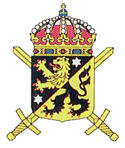
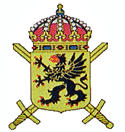
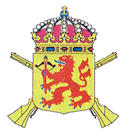
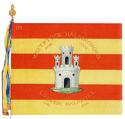
1. Uppland Regiment, I8
2. Skaraborg Regiment, I9
4. Södermanland Regiment, I10
5. Kronoberg Regiment, I11
5. Jönköping Regiment, I12






















